Grains: Bakery and Beyond
INGREDIENTS
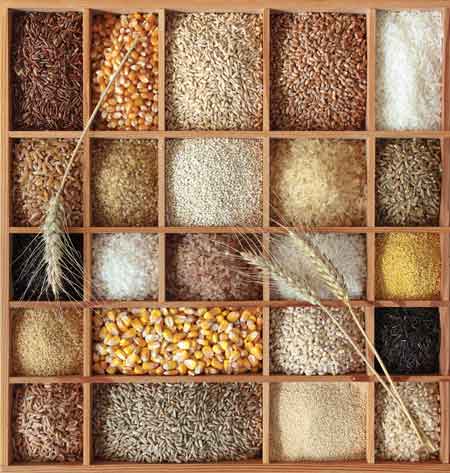 Grains in bakery products. Of course. Grains in beverages, salads, snack foods, confections, and meat dishes. Why not? While grains are key ingredients in bakery products—they’re found in everything from apple pie to zucchini bread—they are also increasingly being used in other applications like veggie burgers, coatings for meat, bowl applications, snack foods, and beverages.
Grains in bakery products. Of course. Grains in beverages, salads, snack foods, confections, and meat dishes. Why not? While grains are key ingredients in bakery products—they’re found in everything from apple pie to zucchini bread—they are also increasingly being used in other applications like veggie burgers, coatings for meat, bowl applications, snack foods, and beverages.
With health and wellness top of mind for many consumers, expect to see more sprouted grains and whole grains—which contain higher amounts of key vitamins and minerals—across product categories as health professionals and nutritionists encourage people to eat more of these nutrient-dense ingredients. As far as specific grains are concerned, corn and wheat are still quite popular, but others like amaranth, barley, sorghum, black rice, millet, and more are gaining traction thanks to the mix of different nutrients they contribute to the diet, their unique flavors, and—when used in whole or piece forms—their visual appeal. Consider using whole grains, heirloom grain varieties, ancient grains, and sprouted grains to create standout food products and menu items, attract new consumers, and stay on-trend.
Expert Input on Ancient, Sprouted Grains
Sprouted and ancient grains are two trending grain ingredients, touted for their health benefits, the differences in flavors and textures that they bring to food products, and their marketing potential. Experts from two leading producers of sprouted and ancient grains gave their insights into formulating with them during an education session at the 2016 International Baking Industry Exposition (IBIE) this past October (Brensing et al. 2016).
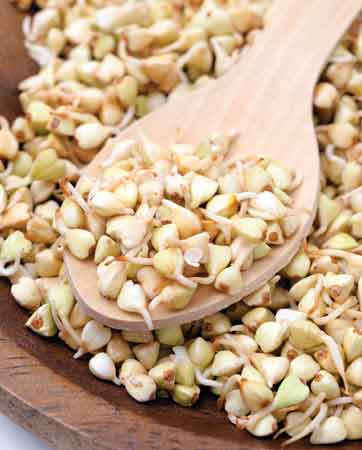 Generally speaking, a sprouted grain is a grain that is in between a dormant seed and a plant, said Sean Finnie, commercial science leader at Bay State Milling, Quincy, Mass. (baystatemilling.com). “But defining when that process begins and when it ends is somewhat difficult to do, and the industry does not have any standard for that right now,” he explained. “And that is something that we have to work toward to make sure we’re all on the same level playing field in discussing the benefits of sprouted grains.”
Generally speaking, a sprouted grain is a grain that is in between a dormant seed and a plant, said Sean Finnie, commercial science leader at Bay State Milling, Quincy, Mass. (baystatemilling.com). “But defining when that process begins and when it ends is somewhat difficult to do, and the industry does not have any standard for that right now,” he explained. “And that is something that we have to work toward to make sure we’re all on the same level playing field in discussing the benefits of sprouted grains.”
Those benefits include an increased concentration of vitamins, minerals, and antioxidants and improved bioavailability of some of these nutrients. Keep in mind, said Finnie, that the nutritional benefits of sprouting depend on many factors, including the type of grain, the variety of that grain, processing conditions, and the processing time.
Finnie outlined three main steps in sprouting grains. First is steeping the grain in water for 8–24 hours. During this time, there is the release of plant hormones that activate the production of enzymes (amylase, protease, and lipase) that break down the storage components (nutrients) in the grain. The second step involves draining the hydrated grain and moving it into a germination vessel or bed where it is aerated and mixed to allow the grain to use the nutrients to germinate and sprout. Finally, the grain is moved to a kiln to stop the sprouting process and dry it out to a moisture content less than 12%. Finnie added that grain producers can also toast the grain at this point to create additional flavors in it.
Food manufacturers can use sprouted grains in a variety of ways in formulations; the way that they use them and the amounts that they incorporate can affect the extent to which they add a nutritional benefit within the finished food product, explained Finnie. Sprouted grains are typically used in smaller amounts when they top dough or are incorporated into it; however, manufacturers are not going to capture all of the nutritional benefits of sprouting when they are used in such minor amounts, he said. If maximizing the nutritional benefits of sprouted grains in finished products is the goal, added Finnie, “you have to be the dough.” By this, he means using dough that is actually made from sprouted grains as opposed to topping dough with the grains or incorporating them in the dough.
The other grain category of note is ancient grains, which are “grains that are largely unchanged over the last several hundred years,” according to the Whole Grains Council, Boston, Mass. (wholegrainscouncil.org). In other words, ancient grains have not undergone the extensive modern plant breeding techniques that commodity grains have. The category includes einkorn, emmer, farro, Kamut (a trademark for the khorasan wheat variety), and spelt, which are grain ancestors of modern wheat. It also includes millet, teff, triticale, freekeh, and sorghum, and the pseudocereals buckwheat, quinoa, and amaranth. Since these grains originated thousands of years ago in regions all around the world, manufacturers can use this information to tell a story, as Bob’s Red Mill, Milwaukie, Ore. (bobsredmill.com), has done with its Grains-of-Discovery ancient grain line. Packaging for these products, which consumers can purchase in grocery stores and online, features brief descriptions of the origins of each grain in addition to nutritional information and recipe suggestions.
When formulating with ancient grains, manufacturers should have a good understanding of what the finished product will look like, and they need to consider input, process, and applications, said Tess Brensing, technical products manager at ADM Milling, Chicago (adm.com), who also presented at the IBIE session. By input, Brensing meant what type of ancient grain and what variety of that type of grain is being used in the formulation. (She said that different varieties of an ancient grain can have different colors, and that could affect the visual consistency of the finished products.) It is also important to consider how the size and shape of the grains affects how they hydrate. The way the grain is processed—either pin milled or roller milled—can make a difference in the particle size of the flour, and that can influence the functionality of the flour and texture of the finished product, said Brensing. Finally there is the application, or finished product, itself. Brensing explained that other ingredients in the formulation, such as sugar and fat, will influence how the flavor of the ancient grains come through in the final product, and that manufacturers might need to use certain grains over others depending on the flavor desired.
--- PAGE BREAK ---
The Whole Story on Whole Grains
Among other foods, consumers are encouraged to include more whole grains (grains where the germ, endosperm, and bran are all present) in their diet; whole grains are a source of dietary fiber, vitamins A and B6, iron, zinc, folate, and other important nutrients. According to the 2015–2020 Dietary Guidelines for Americans, “Healthy eating patterns include whole grains and limit the intake of refined grains and products made with refined grains, especially those high in saturated fats, added sugars, and/or sodium, such as cookies, cakes, and some snack foods. …The recommended amount of grains in the Healthy U.S.-Style Eating Pattern at the 2,000-calorie level is 6 ounce-equivalents per day. At least half of this amount should be whole grains,” (HHS/USDA 2015).
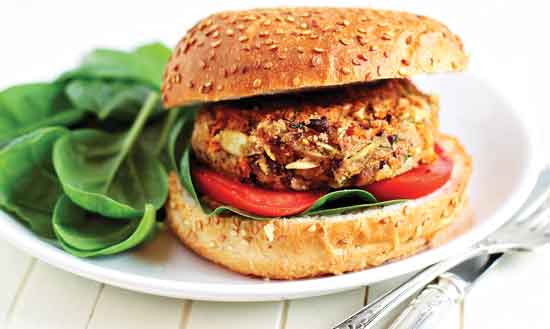 With the push to eat more whole grains as a key component of the current dietary guidelines, health-conscious consumers are looking for whole grain options in the foods they purchase in both grocery stores and restaurants. Product developers have answered the call, and through trial and error, they have formulated a large array of great-tasting products and menu options using a variety of different whole grain ingredients. Quinoa is one of the most popular and fastest-growing grains featured on menus with sorghum, freekeh, amaranth, and black rice showing up more as side dishes, accompaniments with meat and fish, and in burgers, salads, pasta, and soups, according to Mark DiDomenico, director, client solutions at Datassential, Chicago (datassential.com), and one of several speakers at the Whole Grains Council’s Whole Grains Away from Home conference held in September (DiDomenico 2016). Menu items with these and other grains that he pointed out included quinoa burgers, five-grain oatmeal, vegan burritos with farro and brown rice as two ingredients in the filling, chicken piccata with amaranth flour in the crust, and buckwheat banana pancakes.
With the push to eat more whole grains as a key component of the current dietary guidelines, health-conscious consumers are looking for whole grain options in the foods they purchase in both grocery stores and restaurants. Product developers have answered the call, and through trial and error, they have formulated a large array of great-tasting products and menu options using a variety of different whole grain ingredients. Quinoa is one of the most popular and fastest-growing grains featured on menus with sorghum, freekeh, amaranth, and black rice showing up more as side dishes, accompaniments with meat and fish, and in burgers, salads, pasta, and soups, according to Mark DiDomenico, director, client solutions at Datassential, Chicago (datassential.com), and one of several speakers at the Whole Grains Council’s Whole Grains Away from Home conference held in September (DiDomenico 2016). Menu items with these and other grains that he pointed out included quinoa burgers, five-grain oatmeal, vegan burritos with farro and brown rice as two ingredients in the filling, chicken piccata with amaranth flour in the crust, and buckwheat banana pancakes.
“Part of the momentum for whole grains also has to do with the issue of quality,” said Kelly Toups, program director at the Whole Grains Council, and another speaker at the conference. “A lot of whole grains and ancient grains in particular have these vivid stories and they really carry the cachet of being foodie-favorite ingredients” (Toups and Harriman 2016).
The interest comes at a time when people are rethinking nutrition. Toups mentioned how consumers’ relationship with nutrition is changing. “People are sick of hearing low fat, low calories, less this, less that,” she said. She called this the “more message,” meaning that healthy does not equate with deprivation. “The relationship with nutrition is also changing in that it’s more qualitative rather than quantitative. People are starting to step away from the idea of just calorie counting or just counting grams of certain things as the picture of health is really taking a more holistic view of nutrition,” she explained.
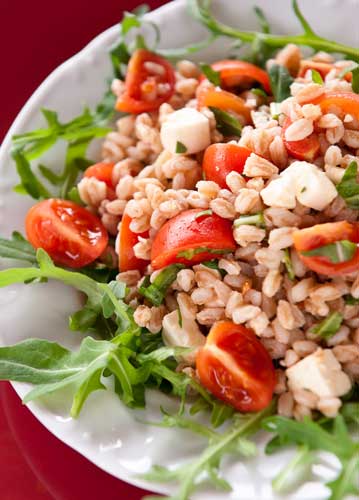 Toups’s presentation focused on the increasing use of whole grains in foodservice menu options, and she said it begins with developing strategies to reach both types of consumers: “health seekers” who want more whole grain options and “fast and familiars” who want familiar and convenient food options and who could be easily deterred if they suspect that something is healthy. “For the health-seeking group, they want their food to be crave-worthy, they want it to be convenient, but they also want to feel good about what they’re eating,” she said. “Millennials are definitely helping drive this trend, wanting food that is good for them, but not wanting to sacrifice their on-the-go lifestyle. For this reason whole grains are really helping to anchor the trend of these healthy fast-casual meals.”
Toups’s presentation focused on the increasing use of whole grains in foodservice menu options, and she said it begins with developing strategies to reach both types of consumers: “health seekers” who want more whole grain options and “fast and familiars” who want familiar and convenient food options and who could be easily deterred if they suspect that something is healthy. “For the health-seeking group, they want their food to be crave-worthy, they want it to be convenient, but they also want to feel good about what they’re eating,” she said. “Millennials are definitely helping drive this trend, wanting food that is good for them, but not wanting to sacrifice their on-the-go lifestyle. For this reason whole grains are really helping to anchor the trend of these healthy fast-casual meals.”
Toups outlined some ways to reach consumers in the fast and familiars group with whole grains such as introducing whole grains into a new menu option or adding whole grains into existing products, preferably in a gradual way or by taking a stealth approach. This can be as simple as adding cooked whole grains to a salad or formulating sandwich bread with whole grains. Toups’ copresenter Cynthia Harriman, director of food and nutrition strategies at Oldways, Boston, Mass. (oldwayspt.org), said that major QSR chains like Wendy’s, Chick-fil-A, Panera, Subway, and Dunkin’ Donuts offer foods with whole grains, many that go beyond a wheat bun or brown rice. Flatbread sandwiches, vegetable and grain bowls, salads, and side dishes formulated with bulger, oats, quinoa, farro, rye, millet, freekeh, amaranth, black barley, and more whole grains are some of the offerings. “These are groundbreaking things from some mainstream restaurants that are really trying to break out and make sure that they are feeding the need for whole grains,” said Harriman.
Perspectives on the Grain Trend
There’s no doubt that grains are a big ingredient trend, especially when regional and nationwide QSR chains offer food made with different types of whole grains, ancient grains, and sprouted grains. Kara Nielsen, a culinary trendologist based in San Francisco, dialed down the larger grain trend to show how it is evolving in five areas she called the mill, the bread, the bowl, the burger, and the grain during her presentation at the Whole Grains Council conference (Nielsen 2016).
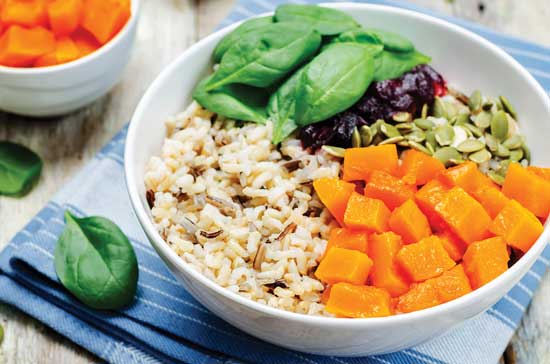 Part of what she called the “new grain economy,” are grain mills springing up to serve a region or community. These mills are run by farmers, bakers, brewers, and chefs, and often specialize in small-batch heirloom grains, she said. Restaurants are even jumping on board, she added, with Emmer & Rye in Austin, Texas, serving pastas and other dishes made with grains that chef-owner Kevin Fink grinds himself on the premises. The grain mills in restaurants are great, but Nielsen said there are opportunities to introduce consumers to this by installing grain mills in grocery stores like the one at the Whole Foods Market in Berkeley, Calif. There, she said, a small grain mill is set up within the store’s home brewer’s area. Customers can purchase the grains for their brewing projects and mill them right in the store. “What’s really key about this is the access and visibility,” she said. It is quite common to see stores that feature coffee grinders for consumers to purchase freshly ground coffee, she said, so perhaps more in-store grain mills are next.
Part of what she called the “new grain economy,” are grain mills springing up to serve a region or community. These mills are run by farmers, bakers, brewers, and chefs, and often specialize in small-batch heirloom grains, she said. Restaurants are even jumping on board, she added, with Emmer & Rye in Austin, Texas, serving pastas and other dishes made with grains that chef-owner Kevin Fink grinds himself on the premises. The grain mills in restaurants are great, but Nielsen said there are opportunities to introduce consumers to this by installing grain mills in grocery stores like the one at the Whole Foods Market in Berkeley, Calif. There, she said, a small grain mill is set up within the store’s home brewer’s area. Customers can purchase the grains for their brewing projects and mill them right in the store. “What’s really key about this is the access and visibility,” she said. It is quite common to see stores that feature coffee grinders for consumers to purchase freshly ground coffee, she said, so perhaps more in-store grain mills are next.
Next Nielsen talked about bread, bowls, and burgers, three products that are leveraging the popularity of grains. The artisan bread movement can be due, in part, to husband and wife Chad Robertson and Elisabeth Prueitt, founders of the critically acclaimed Tartine Bakery in San Francisco. This highly influential couple (he is a bread baker and she a pastry chef) began by baking bread in a stone oven and selling it at a farmer’s market in Berkeley, Calif., where it became quite the cult item, said Nielsen. Since that time, they traveled and trained in Europe, and when they returned, they began using some of the baking techniques that they learned to develop artisan bread products sold at Tartine Bakery. Today, up and down the West Coast and in many other areas of the country, said Nielsen, the popularity of artisan bread has grown so much that consumers can purchase a freshly baked baguette from a baking/vending machine called Le Bread Xpress in San Francisco. Like artisan bread, consumers can expect to see more bowl concepts that feature grains in both restaurants and in grocery stores. Other opportunities Nielsen pointed out were grain bowl bars in schools that allow students to blend their own grains and other ingredients, precooked grains that to-go businesses and foodservice operators can use to quickly prepare bowl products, and frozen grain bowls. Grains are also important ingredients in burgers, adding nutrition and texture to veggie burgers and in the case of meat and grain burgers, reducing the amount of beef used.
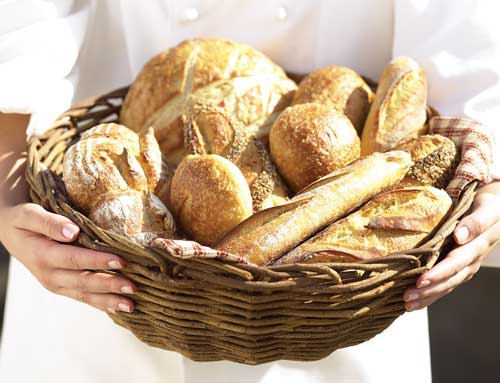 Nielsen wrapped up her presentation by discussing some of the intriguing ways chefs and product developers are elevating the status of grains. Rye, for example, is no longer just for a standard rye bread. Chefs and bakers have discovered the unique flavor and chewy texture of this grain and have baked it into brownies and chewy chocolate chip cookies, said Nielsen. The grain is also used in beverages like beer; Nielsen mentioned a new beer from Guinness, Rye Pale Ale, which is brewed with rye. Other grains like millet, purple corn, black rice, and Job’s tears (a chewy, slightly sweet grain grown across Asia) are on Nielsen’s list of trending grains.
Nielsen wrapped up her presentation by discussing some of the intriguing ways chefs and product developers are elevating the status of grains. Rye, for example, is no longer just for a standard rye bread. Chefs and bakers have discovered the unique flavor and chewy texture of this grain and have baked it into brownies and chewy chocolate chip cookies, said Nielsen. The grain is also used in beverages like beer; Nielsen mentioned a new beer from Guinness, Rye Pale Ale, which is brewed with rye. Other grains like millet, purple corn, black rice, and Job’s tears (a chewy, slightly sweet grain grown across Asia) are on Nielsen’s list of trending grains.
The experts agree that formulating products and using grains in restaurant options presents food manufacturers, chefs, and foodservice operators the chance to diversify their offerings and capture new consumers. Whatever approach is best—formulating a food that includes unusual ancient grains or sticking with more common grains like whole grain wheat or brown rice—food developers have more grain options than ever from which to choose for use in bakery and many other types of food products.
Next month’s Ingredients section will discuss coffee and tea.
--- PAGE BREAK ---
Four-Grain Kolache
An on-trend, bite-sized Caramel Apple Streusel Kolache product concept featured several grain ingredients from ADM, Chicago (adm.com). The kolache, served at the 2016 International Baking Industry Exposition, was formulated with two different kinds of flour—wheat and sorghum—and organic quinoa flakes and organic rolled oats. The flakes and oats were used in the streusel that topped an apple filling. ADM produces an extensive line of flours and ancient grains. Its line of wheat flours and dry milled corn ingredients are developed to meet the functional needs of specific applications. The company offers malted barley flour, farina, wheat bran, cracked wheat, crushed wheat, recleaned wheat berries, bulger, and rye flour as well as several rice flour and rice grit ingredients. Manufacturers looking for ancients grains can choose from amaranth, buckwheat, buckwheat groat flour, millet, pregelled millet flour, sorghum, quinoa, hemp, and teff. There are also many gluten-free, organic, and non-GM versions.
GM-Free Ancient Grains
Bunge North America, St. Louis, Mo. (bungenorthamerica.com), introduced a Non-GMO Project Verified line of milled ancient grains during the 2016 SupplySide West show and the 2016 International Baking Industry Exposition (IBIE), both held this past October in Las Vegas. The ancient grains are available in multiple forms—flours, meals, grits, and extruded products—and in both whole grain and refined versions. At the IBIE show, Bunge served product concepts made with new ancient grains, such as Sticky Toffee Pudding and Drop Biscuits made with whole grain millet flour, Cocoa Nib and Quinoa Shortbread with whole grain quinoa flour, and Spicy Vegan Sorghum Gingerbread made with whole grain sorghum flour.
Seasonings Enhance Grain Flavor
Research points out the health benefits of consuming whole grains, ancient grains, and sprouted grains, and manufacturers like to use them in formulations because they are attractive to many consumers. Some of these grain ingredients, however, have “strong” flavors that may not appeal to the average consumer. Using seasoning blends is one way to overcome this. “We provide seasoning blends with flavor profiles that enhance and compliment the particular grains being worked with, whether it be for crackers, side dishes, baked goods, soups, or snacks bases,” says Jamie Smith, food scientist at Wixon, St. Francis, Wis. (wixon.com). “We have customers who manufacture grain crackers that contain multiple grains such as flax, amaranth, and quinoa,” says Kim Cornelius, senior scientist at Wixon. “The seasonings for these types of crackers need to be very bold in taste and have small visual pieces to enhance consumer appeal. We also may use flavor maskers to offset the sometimes-strong flavor of certain grains that can come across sour or bitter. Both the seasoning and flavor maskers can be incorporated into the cracker dough base itself or used as a topical seasoning for the cracker.”
The product development experts at Wixon also offer up insights into what their customers are asking for and how this is shaping trends in grains. “Ancient grains are still very hot, as we see them being used in drinks, snack foods, side dishes, and nutrition bars,” says Cornelius. “Quinoa is still the most prominent grain being used, but the use of amaranth, teff, and freekeh is growing.” Smith agrees that ancient grains are popular and says that customers are using whole grains and low-GI grains as well. Wixon’s customers are also recognizing the reported health benefits of whole grains. “Our customers are increasingly asking us to formulate their products with whole grain flours, and, of course, gluten-free baking mixes and other products are in demand,” says Roni Eckert, senior scientist. “To deliver a more nutritional ingredient profile, along with rice flour, we have been adding millet, sorghum, and amaranth.” Customers want these products that are formulated with grains to be clean label, adds Eckert. “That means no corn syrup solids, using ingredients that are non-GMO, and replacing beet sugar with cane sugar.”
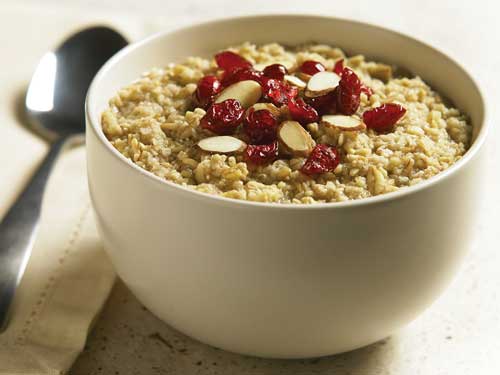 Rethinking Grains’ Potential
Rethinking Grains’ Potential
Ardent Mills, Denver, Colo. (ardentmills.com), offers a range of grain ingredients—from traditional flours to the trendy ancient and sprouted grains, many of which were showcased in 18 bakery product concepts at the 2016 International Baking Industry Exposition. Company chef Daniel Marciani and his team organized the product concepts under three themes: grains with a story, mainstreaming nutrition, and enlightened eating.
Manufacturers who formulate with ancient grains and heirloom varieties of grains can tell the story of where these ingredients originated and how they have been largely unchanged by breeding techniques used to develop commodity grains. While these grains are used in traditional dishes, they are also used to add a twist to both classic and contemporary applications. Attendees sampled such innovative concepts as porridge with heirloom wheats and grain and seed blends; rye pumpernickel quesadilla with rye chops, rye pumpernickel, and white rye flour; and a smoked turkey breast, citrus goat cheese, and slaw sandwich on an orange blossom brioche bun made with organic spelt and stone ground whole wheat flour.
With enlightened eating, consumers can feel good about eating foods made with organic and sprouted grain ingredients. Ardent Mills’ sprouted grain ingredients includes three flours and a cracked whole wheat version (the latter adds texture and visual identity), and it offers various flours in organic versions. Cocoa crepes made with organic whole grain teff flour; cake doughnut with puffed amaranth, quinoa sprinkles, and sprouted white spring whole wheat flour; and pancakes made with sprouted white spring whole wheat flour were some of the product concepts featured for the enlightened eating theme.
Grains, especially in their whole or unrefined forms, are packed with nutrition. For the theme of mainstreaming nutrition, Marciani developed six product concepts, five of which featured either Sustagrain Whole Barley Flour, purple barley, or both. These included purple barley blueberry scones, green olive artisan boule, grilled palisade peach tart, roasted hazelnut swirl bread, and pumpkin spice frosted quick bread.
--- PAGE BREAK ---
Ingredient Roundup
For additional grain ingredients, consider the following options to bring functionality, taste, and texture to food products.
• The BeneGrain line of sprouted whole grains from Bay State Milling, Quincy, Mass. (baystatemilling.com), are produced using a controlled germination process that ensures the optimal temperature and moisture conditions, thereby improving the nutrition and taste of the ingredients, according to the company. Choose from sprouted versions of whole wheat, brown rice, amaranth, millet, quinoa, rye, and sorghum (some come in whole form, some in flour, and some in both). All are available in conventional, and all but rye are available in organic.
• Chia seed, while not a grain, is sometimes listed as an ancient grain depending on the source, probably because, like ancient grains, chia has an origin that dates back thousands of years. It is packed with nutrients, and also has water-holding and gelling properties. Benexia, Santiago, Chile (benexia.com), sells chia seed and chia powder for use in bread and other baked products, wraps, cookies, snack chips, spreads, fruit puree, chocolate, and dressings.
• Corbion Caravan, Lenexa, Kan. (corbion.com/bakery), reformulated its line of pre-soaked ancient and whole grains to be processed without a common preservative spray. The company says that it was able to discontinue the use of the spray while still maintaining the quality of the grains.
• As a specialist in dry corn milling, Didion Milling, Cambria, Wis. (didionmilling.com), produces several different types of value-added corn ingredients for the food industry. One of its ingredients that allows manufacturers to add fiber to cereals and snack foods is the HarvestGold whole grain corn flour. The gluten-free grain ingredient is made from 100% yellow corn and is for use in bakery products, breads, cereal, pasta, snack foods, breadings and batters, dough conditioners, and dry mixes.
• Barley, oats, wheat, rye, corn, and various ancient grains from Grain Millers, Eden Prairie, Minn. (grainmillers.com), come in whole, flake, flour, meal, or bran forms for use across most food and beverage applications.
• Add crunchy, crispy, airy, and puffy textures and sweet, nutty flavors as toppings on baked goods and more and as inclusions in cereals, confections, and bars with AncientGrisps from Healthy Food Ingredients, Fargo, N.D. (healthyfoodingredients.net). Ancient grains such as amaranth, quinoa, sorghum, teff, and millet are milled and then extruded to form the pieces.
• Khorasan wheat is an ancient relative of modern durum wheat. Kamut International, Missoula, Mont. (kamut.com), produces the Kamut brand of khorasan wheat and promotes the ingredient as having a naturally sweet, nutty taste and a higher amount of protein than most modern wheat. When used in baking applications, the company claims that the wheat has better absorption properties than regular flour and good elasticity.
• Sprouted grains are trending, mainly due to the health halo that surrounds them. For manufacturers who want to capitalize on this, Puratos, Cherry Hill, N.J. (www.puratos.us/sapore), recently introduced a ready-to-use sprouted whole grain ingredient. It is a presoaked blend of sprouted whole rye, wheat, and triticale grains and wheat sourdough (the wheat sourdough adds a bit of mild fermentation flavor, according to the company).
• Riviana Foods, Houston, Texas (riviana.com), specializes in one grain—rice. The company processes and distributes rice and rice ingredients for commercial brands and industrial customers. Rivland, a partnership between Riviana Foods and Riceland, offers rice-based ingredients such as rice flour, brown rice flour, and precooked rice flour.
• Rich in antioxidants, purple corn can be the perfect addition to products promoted to health-conscious consumers. Because it has a deep purple color, the corn can also be used to add visual appeal in unexpected applications such as tortillas, pasta, and cereal. Suntava, Afton, Minn. (suntavapurplecorn.com), produces purple corn in IQF, freeze-dried kernels, powder, and puree forms for use not only in bakery applications, but also in snacks, popcorn, bars, cereal, granola, salsas, soups, baby food, meal replacement powders, beverages, beer, and pet food.
• In the United States, sorghum has traditionally been used in livestock feed, but lately its nutritional benefits and functional qualities are being highlighted. Sorghum can be produced into whole grain, flaked, whole grain flour, pearled grain, bran, syrup, and popped forms. Try sorghum ingredients in Whole Grain Sorghum Breakfast Cakes, Citrus Salad with Popped Sorghum, and Sorghum Peach Skillet Cake recipes developed by United Sorghum Checkoff Program, Lubbock, Texas (sorghumcheckoff.com, simplysorghum.com).
www.ift.org
Members Only: Read more about grains at ift.org. Type the keywords into the search box at the upper right side of the home page.
 Karen Nachay,
Karen Nachay,
Senior Associate Editor
[email protected]
References
Brensing, T., S. Finnie, and H. Ward. 2016. “An Overview of Grains: Sprouted, Organic and Alternative Grains and Seeds.” Presented at the 2016 International Baking Industry Exposition (IBIE), American Bakers Association, BEMA, and the Retail Bakers of America, Las Vegas, Oct. 8–11.
DiDomenico, M. 2016. “Whole Grain Trend Watch: Searching for the Next Quinoa.” Presented at the Whole Grains Away from Home conference, Whole Grains Council, Rosemont, Ill., Sept. 25–27.
HHS/USDA. 2015. 2015–2020 Dietary Guidelines for Americans, 8th Edition. U.S. Dept. of Health and Human Services and U.S. Dept. of Agriculture, Washington, D.C. http://health.gov/dietaryguidelines/2015/guidelines/.
Nielsen, K. 2016. “Whole Grain Trends on the Horizon.” Presented at the Whole Grains Away from Home conference, Whole Grains Council, Rosemont, Ill., Sept. 25–27.
Toups, K., and C. Harriman. 2016. “Whole Grain Foodservice Momentum: Beyond Wheat, Beyond the Bun.” Presented at the Whole Grains Away from Home conference, Whole Grains Council, Rosemont, Ill., Sept. 25–27.
